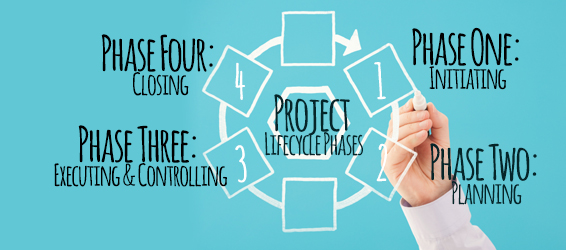Project Lifecycle Phases
Project Lifecycle Phases
The PM Framework Project Lifecycle consists of four distinct phases: (1) Initiating, (2) Planning, (3) Executing & Controlling, and (4) Closing. Each project progresses through every phase, completing a unique set of activities and outputs that depend directly on the requirements and classification of the individual project.
Methods for Applying the PM Framework are determined by the project’s classification.

Phase One: Initiating
The first phase of the Lifecycle focuses on initiating the project beginning with a Project Request and culminating in a signed Project Charter. This phase is initiated when a Project Sponsor identifies a need that meets the definition of a project and submits a Project Request Form. During this phase, the Project Success Center completes a Project Classification Assessment to determine whether the project moves into the PM Framework. One of the major deliverables from this phase is the Project Charter which (1) defines the scope, (2) documents the business case, (3) outlines the roles and responsibilities, and (4) describes how the project will be managed.
Phase Two: Planning
The Planning phase builds on information captured in the Initiating phase and is traditionally considered the most important. It is imperative that project teams do not minimize or overlook planning activities and, as a result, begin deployment activities prematurely. A well-developed and holistic plan helps ensure the project is successfully completed with limited surprises and deviations from the approved charter. The project plan must consist of the schedule and resources for the project and budget requirements. The phase concludes with a team and sponsor-approved Project Plan.
Phase Three: Executing & Controlling
This is the phase where the work gets done according to the Project Plan with the team utilizing an appropriate deployment methodology to deliver the solution. To track the work (the “Controlling” side of Executing and Controlling), the team gathers and reports status, monitors and reports on issues/risks, and, if necessary, creates change requests. This phase concludes when all project deliverables are accepted by the users and the sponsor, and all milestones have been met.
Phase Four: Closing
Projects are temporary in nature and should be formally closed to complete the project lifecycle. Conducting the activities of this phase is vital to continuous improvement efforts and successful transition of the project deliverable. After achieving acceptance of all deliverables, the project team documents lessons learned and archives project documentation for future use. The project manager transfers the project deliverable to operations and support staff, who will maintain it as an operational activity.
Major Activities of the Lifecycle Phases
The PM Framework consists of major activities and resulting outputs specific to each phase. The number and type of activities that a project team completes during each phase is determined by the project's classification. The table below lists the major activities that may be required for each phase in a project’s lifecycle.
| PM Framework Phase Major Activities | |||
| Initiating | Planning | Executing & Controlling | Closing |
| Request Project 1.1 | Conduct Kickoff/Planning Meeting 2.1 | Manage Project Schedule & Budget 3.1 | Conduct Closeout Activities 4.1 |
| Conduct Project Classification Assessment 1.2 | Conduct Planning Meeting 2.2 | Identify and Manage Project Issues and Risks 3.2 | Archive Project Artifacts 4.2 |
| Develop Project Charter 1.3 | Plan Schedule & Resources 2.3 | Manage Communications (Report Status) 3.3 | Transition to Support 4.3 |
| Approve Project Charter 1.4 | Develop Supplemental Plans 2.4 | Manage Changes 3.4 | |
| Approve Project Plan 2.5 | Maintain Project Artifacts 3.5 | ||
| Set up Project Repository 2.6 | |||
